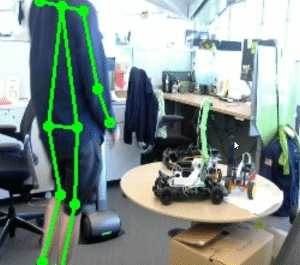FADNet++: Real-Time and Accurate Disparity Estimation with Configurable Networks
This repository contains the code (in PyTorch) for the "FADNet++" paper.
Contents
Introduction
We propose an efficient and accurate deep network for disparity estimation named FADNet with three main features:
- It exploits efficient 2D based correlation layers with stacked blocks to preserve fast computation.
- It combines the residual structures to make the deeper model easier to learn.
- It contains multi-scale predictions so as to exploit a multi-scale weight scheduling training technique to improve the accuracy.
Usage
Dependencies
- Python2.7
- PyTorch(1.2.0+)
- torchvision 0.2.0 (higher version may cause issues)
- KITTI Stereo
- Scene Flow
Package Installation
- Execute "sh compile.sh" to compile libraries needed by GANet.
- Enter "layers_package" and execute "sh install.sh" to install customized layers, including Channel Normalization layer and Resample layer.
We also release the docker version of this project, which has been configured completely and can be used directly. Please refer to this website for the image.
Usage of Scene Flow dataset
Download RGB cleanpass images and its disparity for three subset: FlyingThings3D, Driving, and Monkaa. Organize them as follows:
- FlyingThings3D_release/frames_cleanpass
- FlyingThings3D_release/disparity
- driving_release/frames_cleanpass
- driving_release/disparity
- monkaa_release/frames_cleanpass
- monkaa_release/disparity
Put them in the data/ folder (or soft link). The *train.sh* defaultly locates the data root path as data/.
Train
We use template scripts to configure the training task, which are stored in exp_configs. One sample "fadnet.conf" is as follows:
net=fadnet
loss=loss_configs/fadnet_sceneflow.json
outf_model=models/${net}-sceneflow
logf=logs/${net}-sceneflow.log
lr=1e-4
devices=0,1,2,3
dataset=sceneflow
trainlist=lists/SceneFlow.list
vallist=lists/FlyingThings3D_release_TEST.list
startR=0
startE=0
batchSize=16
maxdisp=-1
model=none
#model=fadnet_sceneflow.pth
| Parameter | Description | Options |
|---|---|---|
| net | network architecture name | dispnets, dispnetc, dispnetcss, fadnet, psmnet, ganet |
| loss | loss weight scheduling configuration file | depends on the training scheme |
| outf_model | folder name to store the model files | \ |
| logf | log file name | \ |
| lr | initial learning rate | \ |
| devices | GPU device IDs to use | depends on the hardware system |
| dataset | dataset name to train | sceneflow |
| train(val)list | sample lists for training/validation | \ |
| startR | the round index to start training (for restarting training from the checkpoint) | \ |
| startE | the epoch index to start training (for restarting training from the checkpoint) | \ |
| batchSize | the number of samples per batch | \ |
| maxdisp | the maximum disparity that the model tries to predict | \ |
| model | the model file path of the checkpoint | \ |
We have integrated PSMNet and GANet for comparison. The sample configuration files are also given.
To start training, use the following command, dnn=CONFIG_FILE sh train.sh, such as:
dnn=fadnet sh train.sh
You do not need the suffix for CONFIG_FILE.
Evaluation
We have two modes for performance evaluation, test and detect, respectively. test requires that the testing samples should have ground truth of disparity and then reports the average End-point-error (EPE). detect does not require any ground truth for EPE computation. However, detect stores the disparity maps for each sample in the given list.
For the test mode, one can revise test.sh and run sh test.sh. The contents of test.sh are as follows:
net=fadnet
maxdisp=-1
dataset=sceneflow
trainlist=lists/SceneFlow.list
vallist=lists/FlyingThings3D_release_TEST.list
loss=loss_configs/test.json
outf_model=models/test/
logf=logs/${net}_test_on_${dataset}.log
lr=1e-4
devices=0,1,2,3
startR=0
startE=0
batchSize=8
model=models/fadnet.pth
python main.py --cuda --net $net --loss $loss --lr $lr \
--outf $outf_model --logFile $logf \
--devices $devices --batch_size $batchSize \
--trainlist $trainlist --vallist $vallist \
--dataset $dataset --maxdisp $maxdisp \
--startRound $startR --startEpoch $startE \
--model $model
Most of the parameters in test.sh are similar to training. However, you can just ignore parameters, including trainlist, loss, outf_model, since they are not used in the test mode.
For the detect mode, one can revise detect.sh and run sh detect.sh. The contents of detect.sh are as follows:
net=fadnet
dataset=sceneflow
model=models/fadnet.pth
outf=detect_results/${net}-${dataset}/
filelist=lists/FlyingThings3D_release_TEST.list
filepath=data
CUDA_VISIBLE_DEVICES=0 python detecter.py --model $model --rp $outf --filelist $filelist --filepath $filepath --devices 0 --net ${net}
You can revise the value of outf to change the folder that stores the predicted disparity maps.
Finetuning on KITTI datasets and result submission
We re-use the codes in PSMNet to finetune the pretrained models on KITTI datasets and generate disparity maps for submission. Use finetune.sh and submission.sh to do them respectively.
Pretrained Model
Update: 2020/2/6 We released the pre-trained Scene Flow model.
| KITTI 2015 | Scene Flow | KITTI 2012 |
|---|---|---|
| / | Google Drive | / |
Results
Results on Scene Flow dataset
| Model | EPE | GPU Memory during inference (GB) | Runtime (ms) on Tesla V100 |
|---|---|---|---|
| FADNet | 0.83 | 3.87 | 48.1 |
| DispNetC | 1.68 | 1.62 | 18.7 |
| PSMNet | 1.09 | 13.99 | 399.3 |
| GANet | 0.84 | 29.1 | 2251.1 |
Citation
If you find the code and paper is useful in your work, please cite our conference paper
@inproceedings{wang2020fadnet,
title={{FADNet}: A Fast and Accurate Network for Disparity Estimation},
author={Wang, Qiang and Shi, Shaohuai and Zheng, Shizhen and Zhao, Kaiyong and Chu, Xiaowen},
booktitle={2020 {IEEE} International Conference on Robotics and Automation ({ICRA} 2020)},
pages={101--107},
year={2020}
}
Acknowledgement
We acknowledge the following repositories and papers since our project has used some codes of them.
- PSMNet from Jia-Ren Chang
- GANet from Feihu Zhang
- PWCNet from NVIDIA Research Projects
Contacts
Any discussions or concerns are welcomed!






